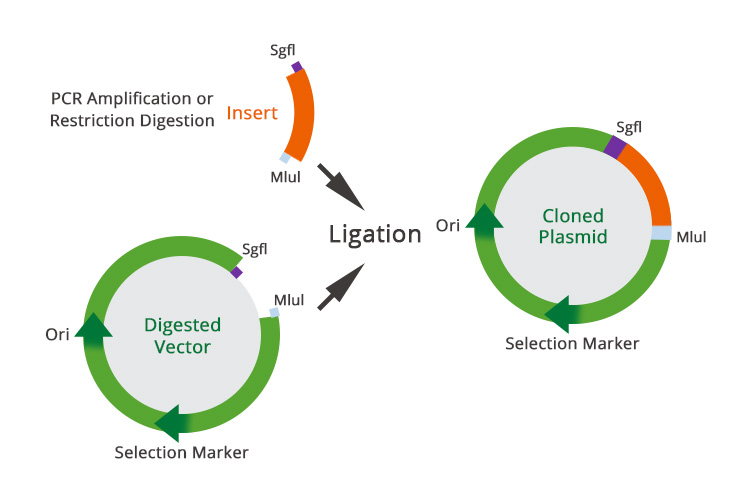Tips on Molecular Cloning
Mar 12, 2019
Molecular cloning is a set of experimental methods in molecular biology that are used to assemble recombinant DNA molecules. These recombinant molecules are used to direct their replication within host organism (1,2). In this article, we describe the basic molecular cloning technique that helps every scientist in their laboratory on a regular basis.
Plasmid based cloning comprises of 4 main steps:
- Insert DNA preparation
- Vector DNA preparation
- Ligation of the insert to the vector
- Transformation into competent cells
In an example below, we will describe how to sub-clone the target insert into a vector using SgfI and MluI.

Insert DNA preparation
- Restriction digestion from a vector containing the insert
- Digest the vector DNA containing the insert with the corresponding restriction enzymes. For our example, the restriction sites used are SgfI and MluI sites. OriGene has genome-wide cDNA expression vectors.
- Run the digested insert DNA on an agarose gel to check the size and perform in-gel purification.
OTI-TIP: Run the purified digested insert on agarose gel to confirm the concentration. The concentration will further help in setting up the ligation. - PCR amplification from template
In cases where the insert cannot be cut with compatible restriction sites, PCR can be used to amplify the insert with the desired cloning sites flanking the target sequences. - Design primers containing the desired cloning sites flanking the target sequences. Free online software programs can be used to design the primers. If manually design them, we recommend the minimal length is about 20bp, GC content at 40-60%, Tm at 60-65°C.
- Amplify the insert DNA from a template by PCR. Purify the product using a PCR purification kit.
- Digest the PCR product with restriction enzymes. Run the digested PCR on an agarose gel and purify the
correct size PCR band.
OTI-TIP: Run purified PCR insert on agarose gel to confirm the concentration. The concentration will further help in setting up the ligation.
Vector DNA preparation
- Choose your best suited cloning vector which contains multiple cloning sites (MCS). OriGene has over 120 mammalian expression vectors, including viral and non-viral
formats.
If you need more vector DNA, you can transform into E.coli competent cells, such as DH5 alpha using heat shock or electroporation method. - Digest 3-5 ug of vector with restriction enzymes compatible with the insert sequence (for example SgfI and MluI
sites). Incubate the restriction digest for 1 hr at 37°C.
OTI-TIP: Longer incubation may be required to make sure the vector is completely digested, but not over 3 hrs.
OTI-TIP: To prevent self-ligation of the vector, dephosphorylate the 5’ end of the digested vector with alkaline phosphatase at 37°C for 30 min. - To decrease the uncut vector plasmid background, we recommend to run the digested vector on an agarose gel, then
purify the linear vector.
OTI-TIP: Run purified digested vector on agarose gel to confirm the concentration. The concentration will further help in setting up the ligation.
Ligation
- For a successful ligation, you may use vector: insert molar ratio of 1:3.
OTI-TIP: A vector: insert ratio between 1:1 and 1:10 could also be used to further optimize ligation reaction. - To determine any background clones arising from self-ligation, set a control ligation with no insert DNA.
- Incubate overnight at 16 oC (or according to the protocol in the ligation kit).
Transformation
- Transform 1-2 uL of the ligation reaction into E.coli competent cells by electroporation or heat shock
method.
OTI-TIP: If the insert is toxic or unstable it helps to use competent cells that specializes in allowing these inserts to amplify successfully. - Transfer into SOC medium to revive the transformed cells. Agitate the SOC medium at 37°C for 1-2 hrs.
- Plate the mixture onto LB with antibiotic plates and incubate at 37°C overnight.
OTI-TIP: For some toxic insert lower temperature and longer incubation period may be necessary. Smaller colonies may be the correct clones. - Screen the colonies for plasmids carrying the target insert sequences. Confirm by digestion, PCR amplification and sequencing
- Watson JD (2007). Recombinant DNA: genes and genomes: a short course. San Francisco: W.H. Freeman. ISBN 0-7167-2866-4.
- Sambrook J. et al (2014) Molecular Cloning: A laboratory manual. ISBN 978-1-936113-42-2


 United States
United States
 Germany
Germany
 Japan
Japan
 United Kingdom
United Kingdom
 China
China
